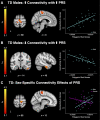Impact of autism genetic risk on brain connectivity: a mechanism for the female protective effect
- PMID: 34050743
- PMCID: PMC8967090
- DOI: 10.1093/brain/awab204
Impact of autism genetic risk on brain connectivity: a mechanism for the female protective effect
Abstract
The biological mechanisms underlying the greater prevalence of autism spectrum disorder in males than females remain poorly understood. One hypothesis posits that this female protective effect arises from genetic load for autism spectrum disorder differentially impacting male and female brains. To test this hypothesis, we investigated the impact of cumulative genetic risk for autism spectrum disorder on functional brain connectivity in a balanced sample of boys and girls with autism spectrum disorder and typically developing boys and girls (127 youth, ages 8-17). Brain connectivity analyses focused on the salience network, a core intrinsic functional connectivity network which has previously been implicated in autism spectrum disorder. The effects of polygenic risk on salience network functional connectivity were significantly modulated by participant sex, with genetic load for autism spectrum disorder influencing functional connectivity in boys with and without autism spectrum disorder but not girls. These findings support the hypothesis that autism spectrum disorder risk genes interact with sex differential processes, thereby contributing to the male bias in autism prevalence and proposing an underlying neurobiological mechanism for the female protective effect.
Keywords: autism spectrum disorder; female protective effect; functional connectivity; imaging genetics; polygenic risk.
© The Author(s) (2021). Published by Oxford University Press on behalf of the Guarantors of Brain. All rights reserved. For permissions, please email: journals.permissions@oup.com.
Figures



